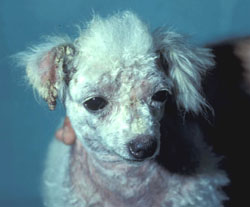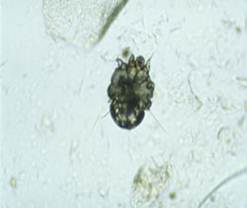| Acariasis Mange | ||
Etiology Acariasis in animals is caused by a variety of mites (class Arachnida, subclass Acari). Due to the great number and ecological diversity of these organisms, as well as the lack of fossil records, the higher classification of these organisms is evolving, and more than one taxonomic scheme is in use. The zoonotic species include the fol-lowing mites. Family Sarcoptidae Sarcoptes scabiei causes sarcoptic mange (scabies) in humans and more than 100 other species of other mammals and marsupials. There are several subtypes of this or-ganism including S. scabiei var hominis, S. scabiei var. canis, S. scabiei var suis, S. scabiei var. equi, S. scabiei var bovis and S. scabiei var ovis. Some of these variants are host specific, some are not, and some have partial host specificity. Family Psoroptidae Most members of this family affect only domestic animals (e.g. psoroptic mange). Rare, self-limiting human infestations with the ear mite Otodectes cynotis have been reported. Family Cheyletiellidae Cheyletiella yasguri, C. blakei and C. parasitovorax cause cheyletiellosis in dogs, cats, rabbits, and some wild mammals. These parasites cause self-limiting dermatitis in humans, who are aberrant hosts. Family Macronyssidae Three mites from this family are known to cause dermatitis in humans. Ornithonys-sus bacoti is found on rodents and small marsupials. It is often associated with black rats. Ornithonyssus bursa (tropical fowl mite) and O. sylviarum (Northern fowl mite) are found on birds. Family Dermanyssidae Two mites in this family will feed on humans, resulting in dermatitis. Both species spend most of their time in the environment, and drop off the host after feeding. Der-manyssus gallinae (chicken mite, red mite, roost mite, poultry mite) is a parasite of birds. Liponyssoides sanguineus is a parasite of small rodents. Family Trombiculidae (chiggers, harvest mites) The approximately 700 species of trombiculid mites are free-living as nymphs and adults, but are parasitic as larvae. Some species can affect animals or humans. Genera known to infest humans include Eutrombicula, Neotrombicula, Schoengastia, Euschoengastia, Acomatacarus, Siseca and Blankaartia. Transmission Female mites lay their eggs either on the host or in the environment. The egg hatches into a larva, which generally passes through two nymphal stages to become an adult. All of the mites that cause acariasis are transmitted by direct contact. The importance of fomites in transmission varies with the species of mite and its survival in the environment.
Treatment Mite infestations are treated with acaricides including lime sulfur, amitraz, phosmet, pyrethrins, coumaphos, malathion, rotenone or carbaryl. The animal may be bathed first with an antiseborrheic shampoo to remove crusts and debris. Ivermectin is used to treat some mites, and dora-mectin has been used for sarcoptic mange. Selamec-tin has recently been reported to be effective for sarcoptic mange and cheyletiellosis. |
||
References:
|




